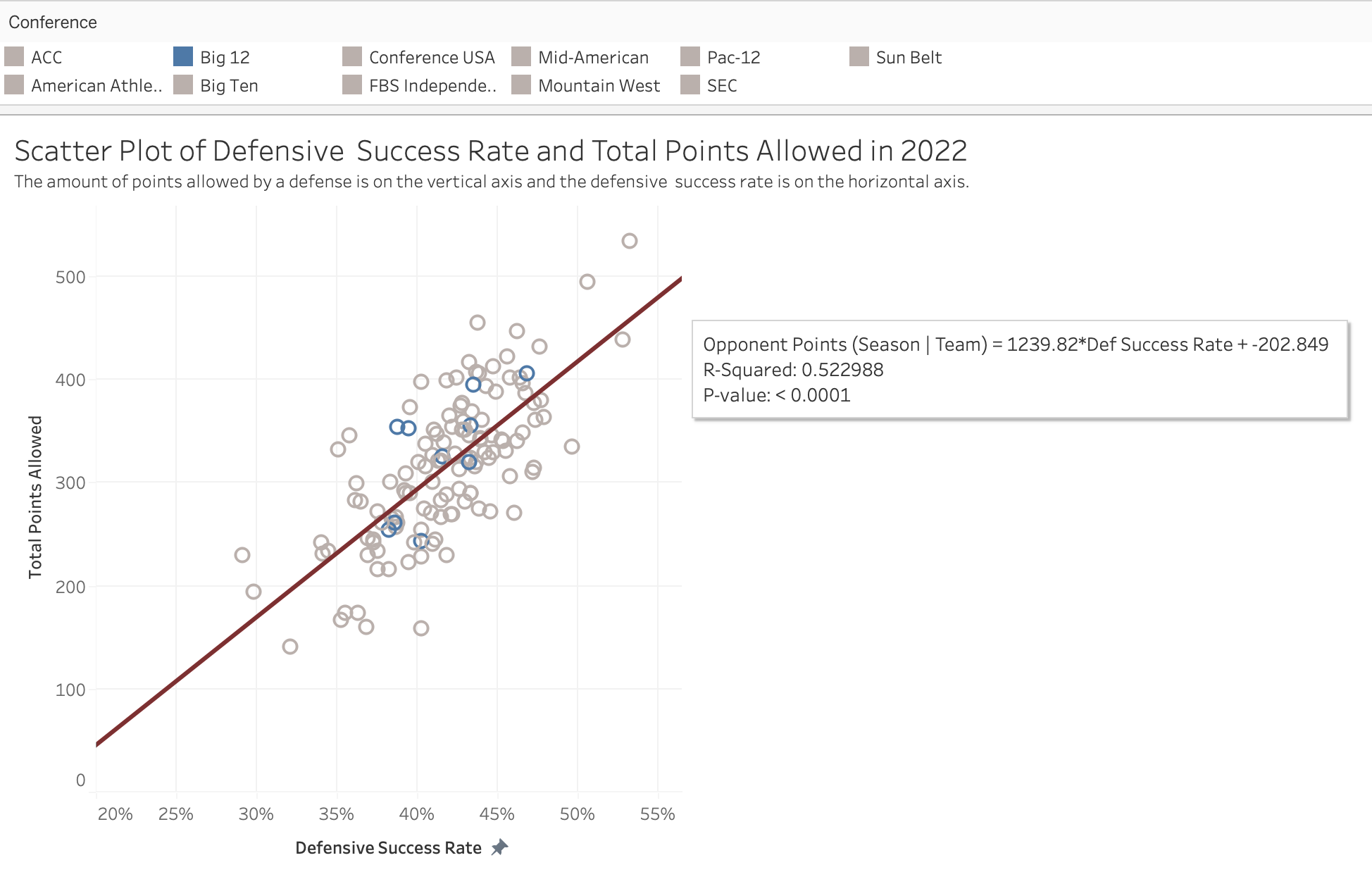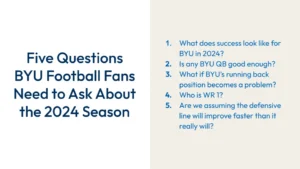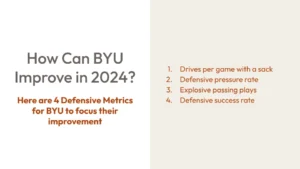As BYU transitions into the Big 12, the BYU fanbase understands the clear need for the BYU’s defense to improve in 2023. But how much does it need to improve? Well, rather than writing a doctoral thesis to discuss this (which I considered doing), I looked at how Big 12 defenses performed in 2022 according to 5 metrics and then contrasted those performances to BYU’s.
The analysis and details come later, but for now, let me cut to the chase and share 5 key takeaways from the analysis:
- First and foremost, BYU needs to stop giving up first downs. If BYU improves its performance on first down, and on second down, and then on third down, then BYU is going to have a much better defense.
- Exciting plays, such as tackles for loss, sacks, interceptions, forced fumbles, etc…are fun, but actually not as important as simply preventing first downs.
- Having a great defense in the Big 12 does not guarantee winning success (ask Iowa State). You must pair that with a really good offense.
- It is possible to win the Big 12 with an average defense (ask TCU). However, you must pair that again with a really good offense (which is what TCU did).
- BYU has some ground to make up in improving their defense in 2023
How do we measure a good defense?
For this analysis, I used total points allowed (or you can look at points per game allowed, it’s the same thing if you look at the regular season) as my metric to index the Big 12 defenses. The lower the amount of points allowed, the better the defense. The higher the points allowed, the worse the defense.
It makes sense to use total points allowed because (a) it is simple and easy to understand, and (b) it makes intuitive sense to the football fan – you must score more points than the other team to win. If your defense allows more points, then your offense must compensate by being better. However, if your defense decreases the amount of points allowed, and your offense simply maintains the amount of points it scores, then your winning percentage is likely to go up.
If you have your doubts about using total points allowed as a good indicator of a defense, then would it help if I told you that Georgia, aka the defending back to back national champions, only allowed 166 points in 2022? Good for 4th best in the country. Oh, and here are a few other notable teams:
- Michigan, a CFP team, allowed 174 points, good for 6th in the country
- Alabama allowed 216 points, good for 8th in the country
- Penn State, Rose Bowl champion over that team north of BYU, allowed 216 points as well, tied for 8th best in the country
How did the Big 12 teams stack up in total points allowed?
So, where did the Big 12 + the new 4 teams land in 2022? (Note, this analysis was completed prior to the Pac-12 apocalypse. Next year, I will include the Four Corner schools as they prepare to enter the Big 12 in 2024).
The following column charts will show:
- Where each Big 12 team ranked within the conference
- Where each Big 12 team ranked nationally
Note that the total points allowed is on the vertical axis in the charts (and will generally be on the vertical axis for the charts that follow after.


Iowa State led the way with the best performance at 243 points allowed. That was good enough for 22nd nationally. Kansas was the worst, allowing 406 points and ranked 120th nationally. No surprise that BYU was in the bottom half, closer to the bottom quarter of the league. BYU allowed 360 points, so a good 117 points more than Iowa State. When you spread those 117 points over 12 games, that’s nearly 10 points more per game.
Yikes! That means that if BYU wants to rank among the best of the Big 12 next year, then they need to allow one less touchdown and one field goal less per game. That means no more of those Oregon or Liberty or Arkansas scoring buffets (“ouch it hurts, stop reminding me!” – all BYU fans). However, if BYU wants to glean some hope, then look at TCU. Right there, about middle of the country, they allowed 325 points. About 3 points less per game than BYU.
Now, TCU had a big time offense that could explode in a millisecond, so, there has to be a good offense paired with a good defense. If Kedon Slovis turns out to be Provo’s Dark Knight, and BYU can limit one less field goal per game, then…ok, I will not say that they’ll go to the College Football Playoff (“I must resist the urge to put the blue goggles on when analyzing…”). But, they could be good.
Interestingly, Cincinnati was literally next in line behind Iowa State, allowing one point more at 244 total. I think it is fair to adjust the performance of the new 4 such that they likely allow another 10%-20% more points last year if they’re playing in the Big 12 given that their strength of schedule last year was not as difficult as it will be this year. That indexed rate would put BYU’s defense at roughly 400 points allowed.
If neither BYU nor Kansas have sufficiently fixed their defenses by September 23rd, when BYU kicks off its historic first Big 12 game, then that game could see both teams scoring like they are opening the basketball season instead.
So, how does BYU’s defense improve?
Let’s dive deeper into each of the 5 takeaways I listed at the onset of this article.
BYU’s defense must do better on 1st down, 2nd down, and 3rd down
Ok, hear me out. I recognize that when you read that headline, you might think, “Danny, it isn’t rocket science that you are explaining here.” At first glance, that headline is as plain and simple as, “BYU’s defense must allow fewer points in order to be better.” Yes. Clearly. Obviously.
But, you must look a little deeper and think this through. ESPN’s advanced data tracks success rate. This is the measure of how well a team performs on 1st, 2nd, and 3rd down. I explain it here when I discuss BYU’s defensive line play from 2022, and it is also explained here by the good folks at collegefootballdata.com
Success Rate is an efficiency metric that determines the success of a play. Successful plays meet one of the following criteria:
- the offense scored
- 1st downs which gain at least 50% of the yards to go
- 2nd downs which gain at least 70% of the yards to go
- 3rd and 4th downs which gain at least 100% of the yards to go
For defensive success rate, the lower the success rate, the better the defense was at preventing the opposing offense from successful yard gainage.
What’s the point? Well, when you look at the data, scoring a low defensive success rate correlates stronger with a lower total points allowed than the relationship between sacks or tackles for loss.
While I would love to see BYU get more sacks and tackles for loss this year, I am more interested in BYU’s defense getting to more 2nd and 7 yards to go than 2nd and 4 yards to go. And I would like to see BYU stop teams on third down much more often than they did last year. It is very, very basic football. Fundamental in fact. But that is partly where last year’s team broke down on the defense. The fundamentals that were lacking last year were that of linebackers stepping up and filling the holes, of 2nd level defenders taking proper angles to the ball carrier, of all defenders driving through the ball carrier and tackling them down to the ground rather than getting fancy and launching themselves or trying to throw the ball carrier to the ground.
It is quite boring to say that BYU needs to do better on first down, second down, and then get off the field by preventing the first down on third down. But, it is as simple as that. BYU was among the worst in the country in defense success rate last year.
A few charts on Defense Success Rate
This first chart shows the relationship between defense success rate and total points allowed. Of the metrics I took a look at in relation to total points allowed, this was the most strongly correlated. With a decent R-Squared value, there is a clear relationship.
The next chart shows how the teams in the Big 12 fared nationally in Defense Success Rate. If you want to find BYU quickly, I’ll give you a hint: look to the very far right where the worst teams performed. BYU’s defense would have been worst in the conference last year and almost worst in the country. While this could be disheartening, the more positive approach is to say, “It can only go up from here…” At least, that is the hope.

It is going to start with the defensive line, and let’s hope they’re ready.
Exciting plays, such as tackles for loss, sacks, interceptions, forced fumbles, etc…are fun, but actually not as important as simply preventing first downs
I took a look at the havoc rate and its impact on the total points allowed, and there was not a strong relationship. Havoc rate = the percentage of plays that resulted in a tackle for loss, forced fumble, interception, or broken up pass. As fans, we want to see more havoc. And, yes, I do believe that BYU’s defense needs to create more havoc.
The graph below shows the relationship, and the R-squared value is about 0.15.
Take a look at the following scatter plot and see where the different teams sit. I’ve highlighted Georgia and Michigan and TCU fairly regularly in these charts because they provide context as 3 of the 4 playoff schools. All three of these schools were around a 16% havoc rate, which is nearly the middle of the country.
On the far right end, with a greater havoc rate, you have Penn State, winners of the Rose Bowl (Penn State fans are somewhere yelling, “The Big Ten is not just a 2 school league at the top…”). Towards the left end, lower in havoc rate is Kansas State, Big 12 conference champions.
These results tell me that BYU’s defense does not need to force a fumble each play or intercept every play. It would help them to do that slightly more often, but I would not guide them towards over aggression and playing risky. Be more aggressive than last year, but, to use an analogy, if last year BYU was driving 50 mph down the 70 mph I-15, then I don’t want them to jump to 110 mph this year. I would like them to get to 70 mph.
Having a great defense in the Big 12 does not guarantee winning success unless paired with a good offense
Iowa State, in my opinion, had the best defense in the Big 12 last year. They allowed the fewest amount of points and only twice allowed teams to score more than 30 points (31 in a loss vs Baylor and 62 in a loss at TCU). However, besides two non-conference games against Ohio and Southeast Missouri State (one of the many Directions & State schools) where they scored over 40 points, Iowa State never scored over 30 points.
In fact, they scored 1 touchdown in 4 games. When BYU plays Iowa State, I expect something in the 14-10, 17-14 range. The moral of the story is that you do need an offense that can put up points in the 30 point range if you want to be really good, and in the high 20s if you want to be competitive in the conference.
Side note, at initial glance, that Iowa game looks like both teams thought they were using golf scoring rules as they tried to keep the points low. However, there might have been more going on, sadly, but time will tell.
Screenshot courtesy ESPN and my Mac letting me grab a screenshot from their website
It is possible to win the Big 12 with an average defense, but, you must pair that with a really good offense
This observation is really about TCU. Look at the metrics provided prior and the following and you will find that TCU is typically middle of the pack defensively. Their defense didn’t lose the games for them (except for Georgia), and their offense won the game for them.
One of the most telling metrics I observed was points allowed per drive. Naturally, when one sees that a team allowed more points than another, such as the woeful Colorado Buffaloes who will be in the Big 12 next year, an immediate question is if their opponents had more scoring opportunities in the form of more drives.
Well, interestingly enough, Colorado was in the bottom quartile of total # of drives defended in 2022 (so was BYU). Both schools were near 130 drives defended. TCU, on the other hand, defended nearly 200 (as did Oklahoma State). However, both schools allowed fewer points than BYU and Colorado. How was this?
See this scatter plot that shows the # of drives defended in 2022.
The answer lies in the amount of points that each team allowed per drive. Colorado and BYU were practically taking dinner orders from the other team: “Alright, what are you having this drive? 1 touchdown? Ok, got it. And what about for the game? 4 touchdowns, 3 field goals, and 2 safeties. Ok, well, we’ll throw in 2 extra touchdowns for you on the house.”
TCU allowed over 1.5 points per drive, whilst BYU’s defense allowed over 2.5 points per drive and Colorado allowed over 4 whopping points per drive. If a team typically defends 10 drives per game, these differences add up. Between TCU and BYU, that’s nearly 10 points per game more allowed. Between TCU and Colorado…well…that gets ugly fast.
BYU has some ground to make up in improving their defense in 2023
I expect BYU to be better defensively in 2023. I looked at one other data point, and that was the average starting field position of their opponents. BYU actually played the field position pretty well. On average, their opponents started at the 28 yard line. The correlation between starting field position and points allowed was also not strong.
However, what it tells me is that schematically, philosophically, and mentally, the BYU defense was outplayed last year. BYU had good field position, and yet they could not get off the field on 3rd down. They had good field position but got off on the wrong foot on 1st down too frequently.
We’ll see where the defense stacks up in the end. If BYU can get their defense in line with the level of Baylor, West Virginia, and even Oklahoma, then BYU will be competitive this year. If they can get to TCU’s level, then I think they can challenge in the conference and will pull off a few unexpected upsets.
It is unrealistic to expect them to be any better than middle of the pack given how far much ground they have to make up, but if they were to get even better than TCU’s defense, then the sky is the limit on the Cougars of BYU in 2023…(how’s that for a blue goggle statement?).
One Last Data Snack
Does it matter where the opponents start with the ball? Well, for BYU it did not matter. On average, their opponents started at their own 23 yard line. So, the common thinking is that if you have less field to go, then you are likely to score more. Well, not always. Let’s say that BYU was really compassionate last year. And Kansas was also pretty nice to opponents. However, they were nearly on the opposite end of the spectrum when looking at where they would start their opponent with the ball. See the scatter plot below.
Data come courtesy of @cfbfastR





